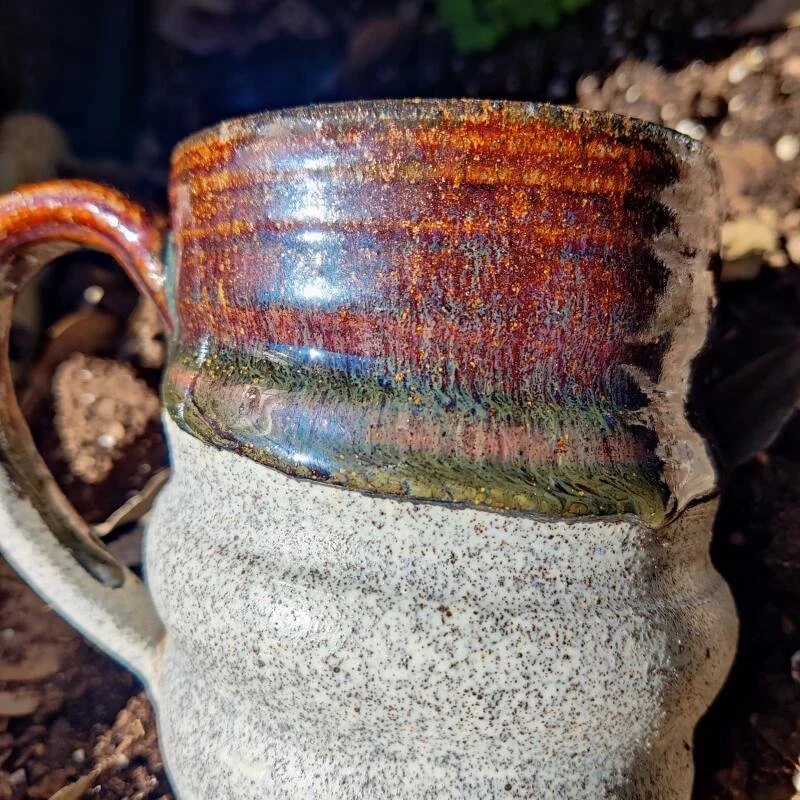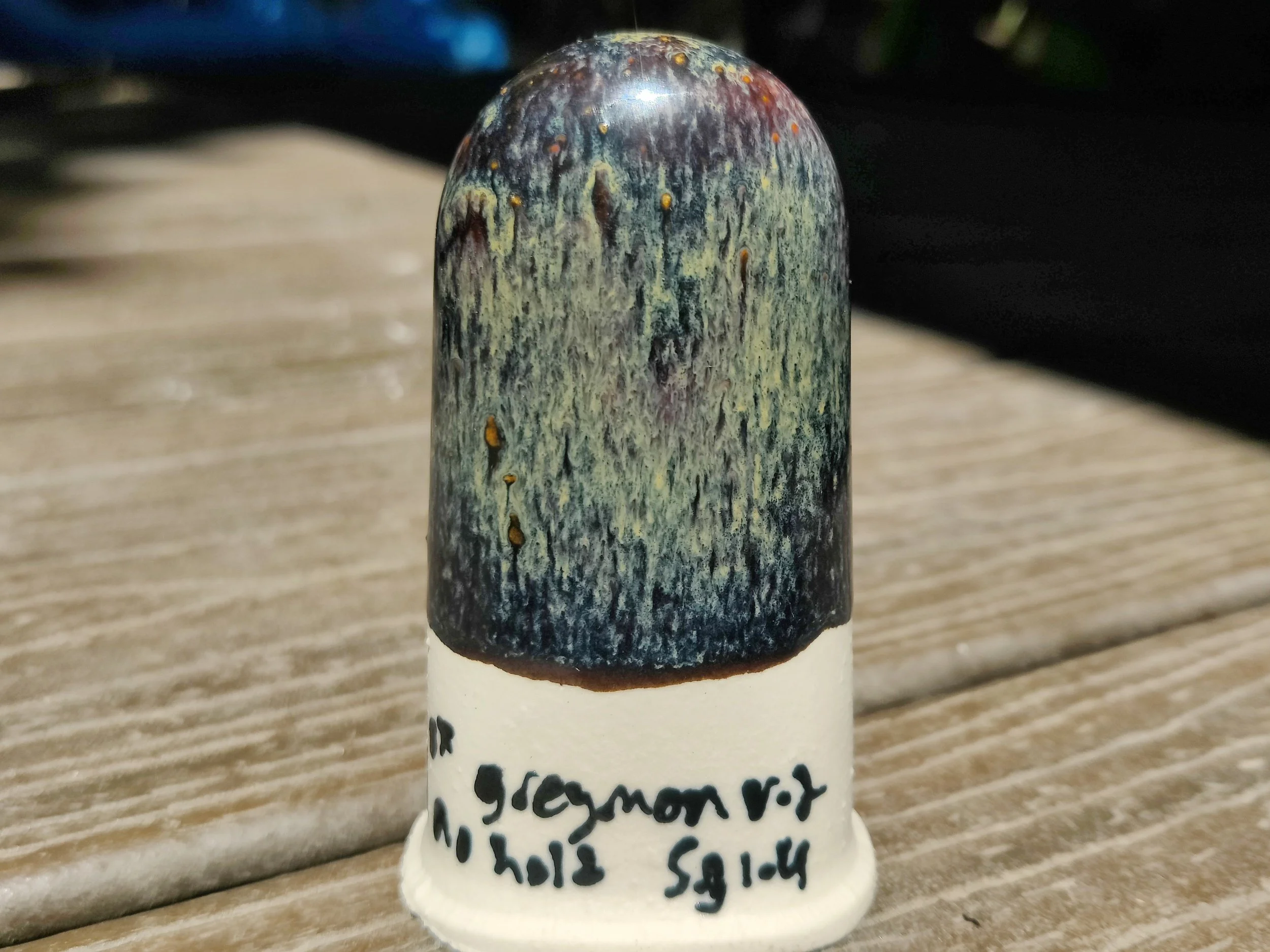New glaze (Greymon V.2)
One of the more popular glazes I have developed is called Greymon. Greymon was developed early in my glaze development days; I knew enough to change recipes, move things around, matt vs gloss. I did not understand how viscosity and water solubility effected the efficacy or efficiency of the glaze yet though. This was a major turning point for me as these two thing do not have much to do with molar amounts in the unity molecular formula. In my experience, most people learn how to make a glaze. From that point they run in to problems that are outside of their control. They only know how to put the recipe together. They know little about the ingredients and how they mesh with each other or the clay. Even people that know how to read the UMF would assume that in order to replicate a glaze all you have to do is move ingredients around until the chemistry matches up. No. This does not take in to account so many things with respects to how the glaze works. This is no more apparent than with my old Greymon recipe. Let’s take a look.
Greymon v.1
Cone 6 ox
Sg: 1.4
Application :4 coats brushed on
Clay: Frost porcelain
This is the original greymon. Worked every time I used it (see pictures below)
Greymon v.1 on Dragon fruit clay from IMCO
Greymon v.1 on recycled clay.
The recipe to Greymon v.1
Looks good, right? But there was a problem. The glaze was working for me but no one else that made it. For context you should know 3 things.
1. I only made small batches of the glaze. 200 grams or so.
2. I put on a thick application of it. At least 4 layers or a 5 second dip ( I knew it was a phase separation glaze and they like to be thick)
3. I used the glaze as soon as I made it. I made it, 1 hour later I used it.
For you who are more experienced, you probably see the problem with these things along with the recipe. Fast forward to this year. The Ceramics Material workshop has taught me about application, viscosity, and how it effects glazes. I now also understand that a glazes viscosity changes from the moment it is made for about 3-4 days. And Viscosity matters! ALOT. Now that I know this, I started letting my greymon glaze sit for a few days. Wouldn’t ya know it….. The viscosity changed. It became thicker, the way I applied to was effected because of this. This also meant I could not make a huge bucket of it. So I had to learn to change the Viscosity with something like Darvan…… Dear lord…. another thing I have to do to the glaze to make it work? Well, I know that applying glaze too thick will cause crawling, we have proven this in other blogs… But I know that if it is too thin it will just turn brown. So I started looking for the sweet spot. Lets take a look at Greymon V.1 with a lesser application.
Greymon v.1
Clay: Frost porcelain
Application: 2 second dip
Sg: 1.2
Cone 6 ox (25 min hold at 1700f)
Thissssssss was the result that other people were getting. People were either getting crawling or just brown. The problem with this is that the glaze likes to be thick. Too thick and it will crawl. Too thin and it wont yield the colors we are looking for.
Make it stand out
Clay: Frost porcelain
Clay: Frost porcelain
Application: 3 second dip
Sg: 1.4
Cone 6 ox (25 min hold at 1700f)
For the next test I wanted to see how high we would take the SG and application. I bumped it up by 0.2 Sg and 1 more second of application. Oh good! we got it! That’s what we wanted. Lets make a triple batch of it at 1.4 Sg and apply it on 2 Porcelain cups for a 4 second dip.
Greymon v.1
… CRAP!. That’s not even close to the original color, that’s brown.
Clay: Frost porcelain
Clay: Frost porcelain
Application: 4 second dip
Sg: 1.4
Cone 6 ox (25 min hold at 1700f)
Greymon v.1
Oh great… Now we have crawling and the color is just turning brown
Clay: Frost porcelain
Clay: Frost porcelain
Application: 5 second dip
Sg: 1.4
Cone 6 ox (25 min hold at 1700f)
At this point I gave in. The lithium is water soluble and expensive, the glaze wanted to be thick but if it is too thick it crawls, if it is too thin it turns brown. It hates being put on a hold, once I make the glaze I have to use it right away because the viscosity changes so much over a few days that the application will be different! WHICH SUCKS BECAUSE THAT MEANS i HAVE TO MAKE A NEW BATCH EVERY TIME I WANT TO USE IT?!?!? heavy breathing . So I took what I learned from the Ceramic materials workshop and just remade the damn glaze without water soluble materials. I made an entirely new base because the base I had for this glaze just does not work well with the recipe (probably the damn iron) and Boom.
may I introduce to you, Greymon V.2 (no, you cant have the recipe and you know why)
Greymon V.2
Oh, this glaze fucks. It is stable, reliable, easy to make, works on different clay, it just fuuuuuuucks.
Sg: 1.4
cone 6 no holds or slow cool
Application : 4 second dip
Clay: B-mix slip cast
Greymon V.2 on IMCO porcelain (carved)
The main thing that seems to change with application here is the amount of yellow. If the temp it a little higher the yellow decomposes. This means any holds or slow cools will get you less yellow. You can also control that with application though.
Sg: 1.4
cone 6 no holds or slow cool
Application : 3 second dip
Clay: IMCO porcelain
Greymon V.2
Sg: 1.4
cone 6 no holds or slow cool
Application : 3 second dip
Clay: AMACO white chocolate
Greymon V.2
Sg: 1.4
cone 6 no holds or slow cool
Application : 3 second dip
Clay: AMACO milk chocolate and dark chocolate mix.
greymon V.2
Sg: 1.35
cone 6 (30 min hold at 1800f)
Application : 3 second dip
Clay: IMCO porcelain
Greymon V.2
Sg: 1.4
cone 6 (30 min hold at 1800f)
Application : 3 second dip then a 2 second dip from the half way up point.
Clay: IMCO porcelain
A few notes about Greymon V.2. It seems to be more yellow/blue/brown than it does Brown/blue/yellow. The main way to change this is too control the application or the Sg. I find that I get less yellow with a 1.3 Sg and 4 second dip than I do with a 1.4 - 1.45 Sg and 4 second dip. Some people I have shown this to enjoy less yellow, so there, that’s how you control that. This was quite the adventure. But the fruit of testing are very very delicious….. ok bye.














